Follow the Trend – Pros and Cons of Trend Trading
Follow the Trend – Pros and Cons of Trend Trading
Successful speculation is the art of being right about the future market’s direction. Statistically, traders that follow the trend stand better chances of being right about the market’s direction. Therefore, success in trading directly relates to trend trading.
To follow the trend is a piece of cake.
Simply take any moving average and apply it on a chart. Next, buy dips when the market is trending. Finally, wait for the market to make a new high before moving the stop-loss to break-even.
However, trading isn’t that easy. If it was, everyone would trade the financial markets.
Instead, today’s trading is a dog-eat-dog world. It changed in the last year as much as it changed in the last decade.
Due to the complexity of financial markets, no trading day is the same.
Contents in this article
- Follow the trend
- Follow the Trend – The Good, The Bad and The Ugly In Trading
- The JPY Melt-Up – Impossible to Follow the Trend
- Most Trend Indicators Lag Price Action
- Keep an Eye on the Big Picture – Follow the Rules of a Trend
- Avoid the Emotional Rollercoaster When Following the Trend
- News Trading When Following the Trend
- EURUSD and the Fed’s Decision – What Kills Trend Trading
- Cons of Trend Trading – When News Kicks You Out of a Good Trade
- Follow The Trend- Final Words
Follow the trend
Trading strategies that follow the trend, therefore, might work in some cases. But, could also fail in others.
 Differences exist everywhere. From one market to another, and even within one and the same market.
Differences exist everywhere. From one market to another, and even within one and the same market.
For instance, the currency market shows extreme differences between currency pairs. As such, some pairs trend more than others.
The easiest way for determining that distance is to use the ATR indicator. The acronym stands for Average True Range, and it represents an indicator offered by all trading platforms.
It shows the distance the market travels, on average, in a certain period of time. The higher the reading, the more chances that strategies that follow the trend will work on any given market.
Trend trading is so popular among retail traders that it deserves special attention. For this reason, this article aims at revealing the pros and cons when traders follow the trend.
So, what is the best approach to trend trading?
Follow the Trend – The Good, The Bad and The Ugly In Trading
As you’re about to find out, the rules to follow the trend are simple. Unfortunately, the problem does not come from the rules or the system.
Instead, it comes from the complexity of the currency markets. And, of the financial markets in general.
Today’s trading is mostly algorithmic. Simply put, done by robots.
We, humans, barely follow robots’ decisions. Each trading day and week the complexity of the systems run by machines increases.
This is a blessing but also a curse for the retail trader. It’s a nasty thing because ranges occur more often. Hence, a “follow the trend” strategy has little chances to succeed.
On the other hand, it is a good thing because the more stops the market trips, the more the algos buy or sell in the that direction. It is like adding fuel to the fire when the market comes back to the mean.
This is how stronger trends form, but also trends that traders have a challenging time riding.
Algorithmic trading is all about speed. More precisely, the speed of execution.
When it moves, the market does that so fast that retail traders don’t have the time to react. 2019 is the perfect example for that.
The JPY Melt-Up – Impossible to Follow the Trend
2019 started with a blast. The JPY “melted up” right from the start of the trading year.
For those that don’t know, the JPY forms a special currency part of the Forex dashboard. Traditionally, it has a lower interest rate, as the Bank of Japan fought terrible deflationary pressures in the last several years.
Therefore, investors in search of a higher yield borrow cheap money when they buy stocks. As most of the hedge funds and big institutional players use the USD and are active on the U.S. equity markets, the flow goes through the USDJPY: investors borrow in JPY and buy USD to pay for equities. Hence, USDJPY rises with the U.S. equities.
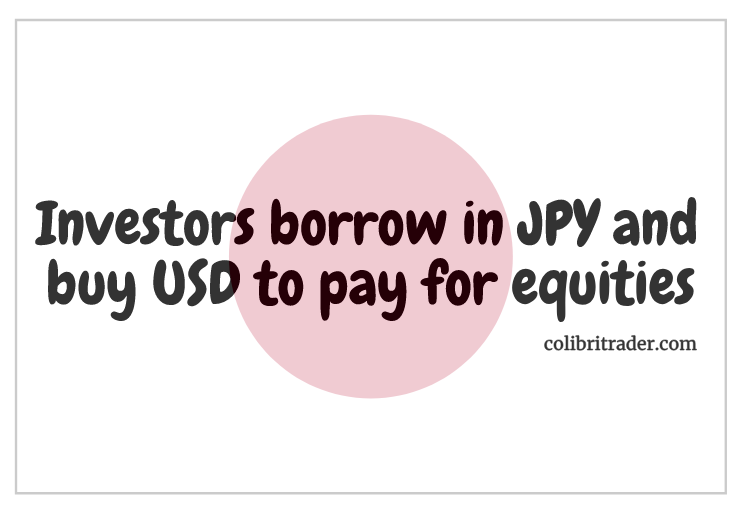 Naturally, the opposite happens in a so-called “risk-off” situation. Only that in this case, the race is on for who leaves the party first.
Naturally, the opposite happens in a so-called “risk-off” situation. Only that in this case, the race is on for who leaves the party first.
With equities selling, the JPY strengthens, as investors need to repay the JPY loans. This adds fuel to the fire and the JPY trips stops along the way up.
It is a perfect scenario for a trend following strategy. However, there’s a catch.
Because of the algos’ domination on the market, the entire move does not happen fast. It does happen extremely fast!
In this case, all the JPY pairs sank. And, some other pairs reflecting the risk in the currency market followed suit.

The problem with that move is the speed of it. It happened so fast that those willing to follow the trend had a hard time doing so.
Moreover, it was quickly retraced. And don’t say that trading on the lower timeframes would solve it. In fact, the chances to be stopped out increase when trading the lower timeframes.
Therefore, systems that follow the trend have a hard time in today’s markets. Expect the same for the period ahead.
Most Trend Indicators Lag Price Action
Unfortunately, that’s a powerful statement. The trend is your friend, so they say!
But trends do not form that often anymore. Ranges, instead, dominate the price action.
And even when the market enters into a strong trend, the indicators available to follow the trend lag price action. More precisely, they offer a delayed signal as to the market’s direction.
Take the moving averages, for instance. Traders use them to find bullish or bearish markets.
For instance, the “golden cross” is a bullish signal. It shows the market entering the bullish territory.
Alternatively, a “death cross” shows bearish conditions. When the MA(50) drops below MA(200), it is a trend signal to go short. Or, is it?
But by the time the cross forms, most of the price action is behind. To have a competitive advantage, traders fight for early entry in any trend.
Because of that, savvy traders first master reversal patterns. And only then, they focus on how to follow the trend.
What do we need trend indicators then for?
Are they any good?
The straight answer is that they’ve lost their original usefulness. However, they are an essential trading tool for the retail trader.
How come?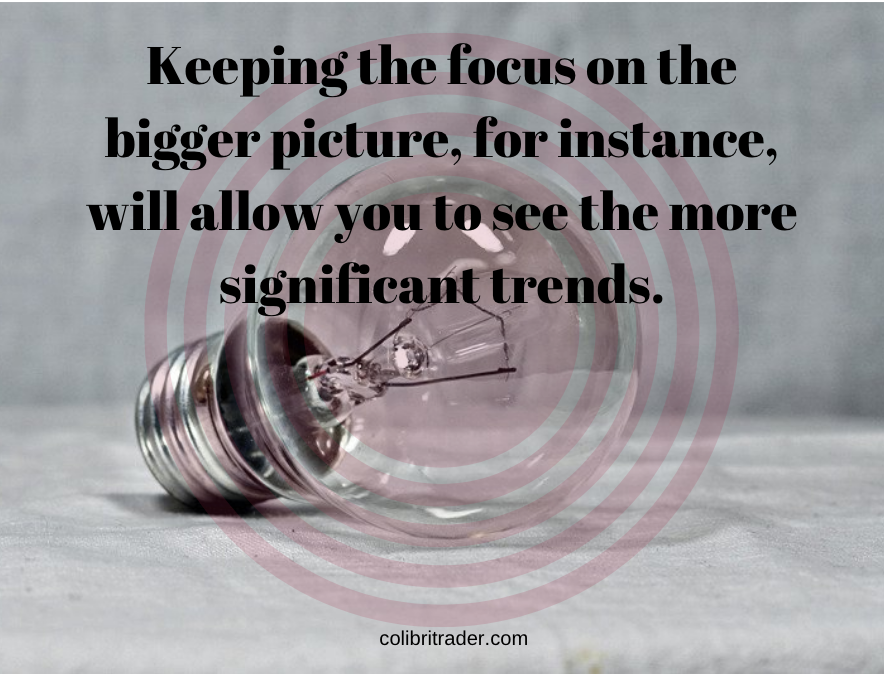
Well, some markets do trend. Keeping the focus on the bigger picture, for instance, will allow you to see the more significant trends.
Thus, you’ll end up filtering the day-to-day noise in the financial market. Instead, you will focus only on what really matters in the markets.
Keep an Eye on the Big Picture – Follow the Rules of a Trend
So far, we discussed only the cons of trend trading. It seems that the retail trader only has obstacles when trying to follow the trend.
Yet, some approaches do work. Avoiding the lower timeframes is one thing that keeps the trader away from costly mistakes.
It may happen that from time to time the market gives false breakout signals. But, if a trader catches a 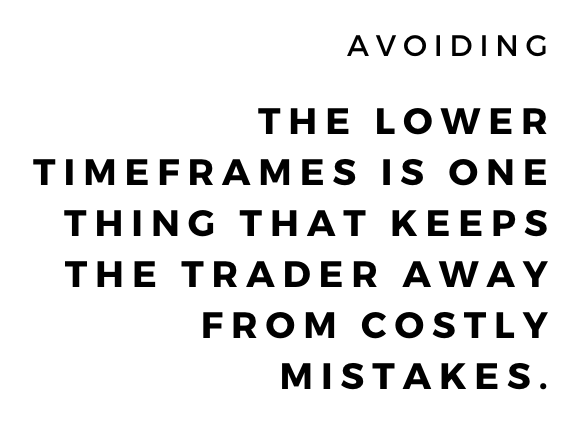 trend on the bigger timeframe (anything from daily timeframe and above), he/she’d better stick to it.
trend on the bigger timeframe (anything from daily timeframe and above), he/she’d better stick to it.
To make the most of riding a trend, traders need to define the rules of it clearly. The series of lower lows completed with lower highs or higher lows and higher highs is crucial.
No one knows when a trend starts. Or, how much it will last.
But, one thing is sure: as long as either of the two series hold, the trend will keep going. One big advantage to follow the trend on a bigger timeframe is that: you do merely forget about the daily market noise.
You do also avoid the emotional rollercoaster. Statistics show that it is almost a certainty that a trade goes against the desired direction in the first moments following its opening.
If you look at your trades, you would probably know that this is true. But, using the bigger timeframes, the pressure eases.

Above is given the AUDUSD pair. The weekly timeframe shows a steady bearish trend.
For the last seven years, the pair only moved lower. Naturally, corrections did occur.
And, if you treated them on the lower timeframes, they seemed to take quite some time. But, in reality, to follow the trend on this pair, all you needed to do is to look at the series that defines it. In this case, lower lows and lower highs.
Avoid the Emotional Rollercoaster When Following the Trend
Focus on the chart above. The numbers represent the lower highs part of a bearish trend.
A trend like this is every trader’s dream. Unfortunately, not all retail traders can trade it.
In fact, very few can. The problem is the time element.
Retail traders have no patience. This is one of the main things that hurts the trading account.
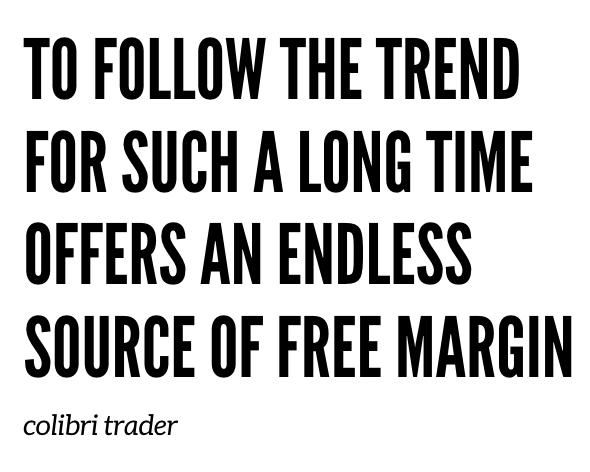 The ones with an affinity for bigger timeframes, though, will enjoy riding a trade like this. To follow the trend for such a long time has many advantages.
The ones with an affinity for bigger timeframes, though, will enjoy riding a trade like this. To follow the trend for such a long time has many advantages.
First, it is an endless source of free margin. Yes, the margin in the trading account is an integral part of the account’s success.
It provides ammunition and funds for new trades. And, more importantly, it diminishes the opportunity cost (i.e., the cost of not taking a trade due to lack of free margin).
Second, riding a trend like this increases confidence. After all, what can go wrong? Just keep lower the stops to the previous lower high.
Finally, it keeps the trader on the right side of the market. Have a look at the chart below.

It is the same AUDUSD weekly timeframe. Only this time, the orange trendline defines the so-called bearish trend, just like most traders will draw it.
If there is a breakout, many will go long. But, is the trend over?
As we clearly see, the market made a new lower low. In doing that, it keeps the pressure on bulls, keeping the bearish trend intact.
Follow the trend till the end!
News Trading When Following the Trend
One of the biggest challenges in a currency trader’s life is to combine the technical and fundamental picture. As it turns out, this is a difficult task.
Economic news comes out regularly. Every first Friday of the month, the NFP (Non-Farm Payrolls) comes out.
Or, every six weeks, one important central bank holds a press conference and decides on the interest rate level. Inflation, Retail Sales, Average Hourly Earnings, GDP (Gross Domestic Product), etc., they all have a terrible effect on any trader’s psychology.
That is, they create doubts. And, when you begin doubting your analysis, the next thing you know is that you get out of the right trade.
The problem with economic news is that trading algorithms are being switched on. They are programmed to buy or sell a currency pair based on the data.
Algorithms interpret the data as bullish or bearish. And, they react instantly.
As such, they have the power to break trends. Or, at least to make it difficult for traders to follow the trend.
The AUDUSD example was easy. Few trends have those characteristics.
What happened lately with the EURUSD pair represents a more likely outcome. Here’s how economic news and algorithmic trading broke a bearish trend.
EURUSD and the Fed’s Decision – What Kills Trend Trading
Since the second half of 2018, the EURUSD is in a bearish trend. All bounces failed.
Perhaps the most important economic event of the first quarter of 2019 was the March Fed’s decision and press conference. Suddenly, economic conditions in the United States changed.
If the December 2018 meeting was hawkish, the Fed signalled it would stop raising rates. Moreover, it signalled the end of the QT (Quantitative Tightening) program, too.
In a way, an understandable decision. It seems that the United States economy is close to the peak of the business cycle.
The markets “felt” the wind of change. And, up to the meeting and press conference, they sold the USD across the board.
The EURUSD was no exception. It rose for almost two trading weeks ahead of the Fed’s decision.
In a bearish trend, it is said that the rallies are more aggressive than the ones in a bullish trend. Obviously, this is due to algos triggering stops.
So, the market challenged the ones that follow the trend on the downside. And, that was ahead of the actual decision.
Cons of Trend Trading – When News Kicks You Out of a Good Trade
The blue horizontal lines in the chart above show the lower highs in the EURUSD bearish trend. Before the Fed’s decision, the trend remained intact.
However, the red rectangle points to the market reaction at the Fed’s announcement. The Fed didn’t blink: it did what it was supposed to do.
The EURUSD and other USD pairs reacted instantly.
Remember the algos?
But the break that followed turned out to be false. The price broke the lower highs series, making it difficult for those that follow the trend to stay in the trade.
One argument remains in place. While the price broke the lower highs series, it didn’t close above them. Hence, some traders argue that the bearish trend remains in place.
Judging by the price action that followed, who can blame them? In any case, news and economic data have the power to kick traders out of significant trends. And, considering the scarcity of trends, this is a terrible thing for trend followers.
The EURUSD example is just one. On the currency market, plenty of examples exist when the market’s reaction to economic releases breaks trends.
In this example, the trend formed on the daily chart. Yet, it didn’t survive, if we consider the piercing of the lower highs series.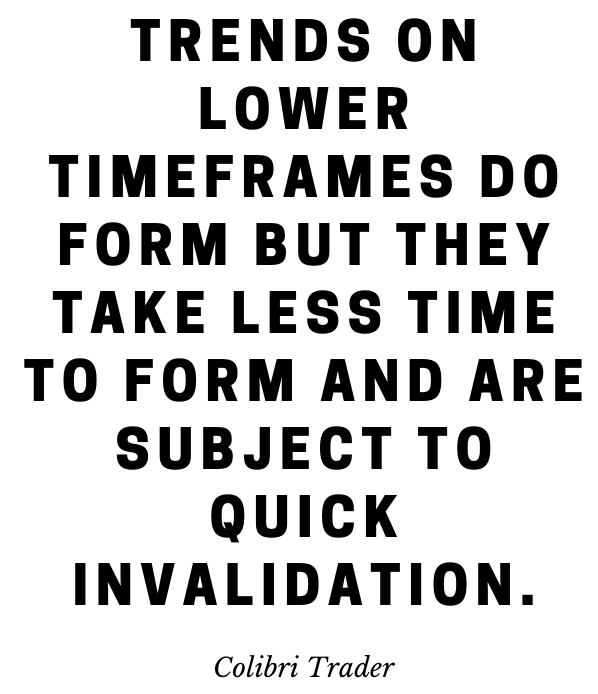
Therefore, one question comes to mind. If trends on daily timeframe have such a hard time, why bothering looking the lower ones?
The truth is that trends on lower timeframes do form. But they take less time to form and are subject to quick invalidation.
Follow The Trend- Final Words
Trading is not a game. Any educational material about how to follow the trend will point out to an ideal situation.
The reality, though, differs. As the currency market’s volatility increases when no one expects, following a trend is a daring task.
As always, discipline helps.
Try focusing on the rules of a trend and don’t overreact to the news.
Stay calm and combine money management rules with trend trading. Also, get used to having a look at the bigger timeframes more often than not. They have the power of keeping the trader on the right side of the market.
Some traders wait for a candlestick to close above or below a trend’s invalidation point.
Is this a wrong approach? Nope, it isn’t.
In the end, every strategy has its good and bad points. What’s key to remember here is that no strategy works one-hundred percent of the time.
As such, trend following is due to failure. Just like any other trading strategy, it can’t, and it won’t work one hundred percent of the cases.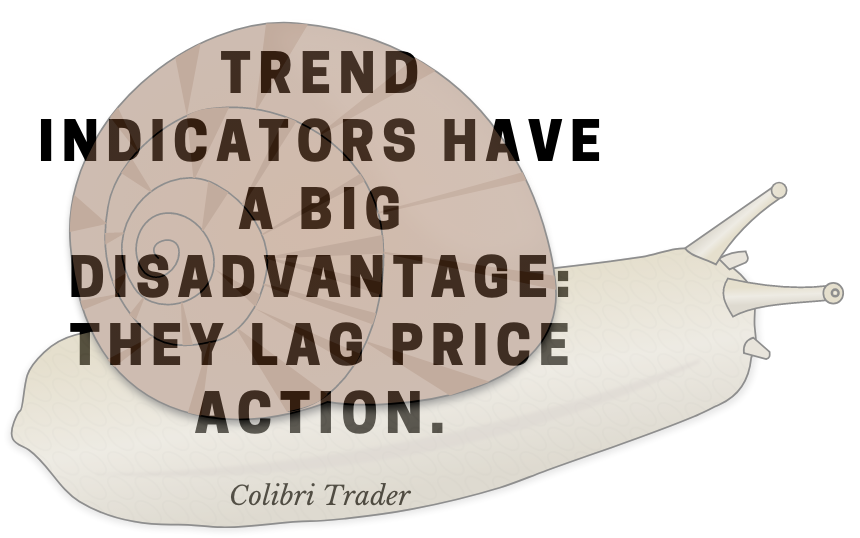
The sooner the trader understands this, the better. Trend indicators, also, have a big negative spot: they lag price action.
Hence, one may rely on the information provided up to one point.
How about trendlines? Well, just go back and review that chart with the fake AUDUSD trendline break and you’ll have your answer.
To sum up, those who follow the trend are better off trading the bigger picture. Thus, having bigger targets in mind will help you reach your goals better.
Are you such a trader ready to wait for the right setup, even if that takes months?
Happy Trading,
Colibri Trader
p.s.
Have you read my other article on trend-following HERE
or my article on 5 trading strategies that follow the trend HERE






Excellent Article. That Audusd weekly chart says it all. It’s hard to stay in the trend. We have to have nerves of steel. I’ll be looking at the bigger picture more often.
Definitely! Higher timeframes are always important! I do start with the higher timeframes and then scaling down